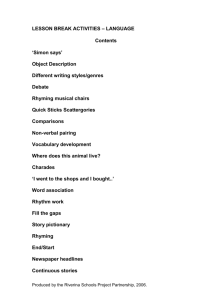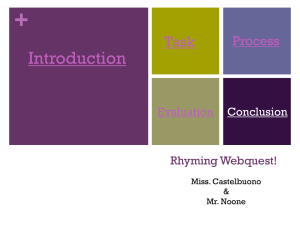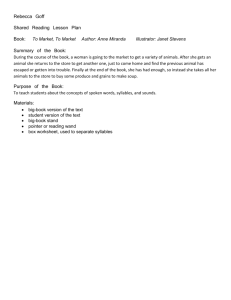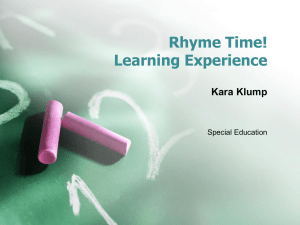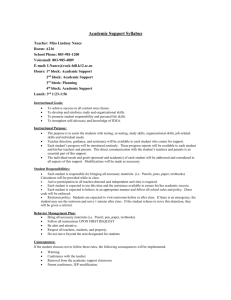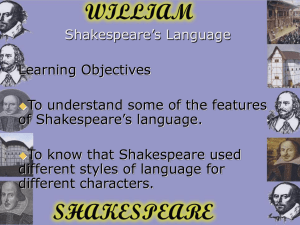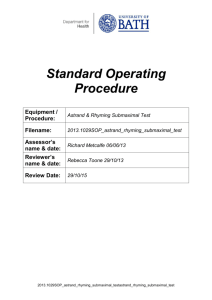Kindergarten Lesson Plans: September 1-5, 2014
advertisement
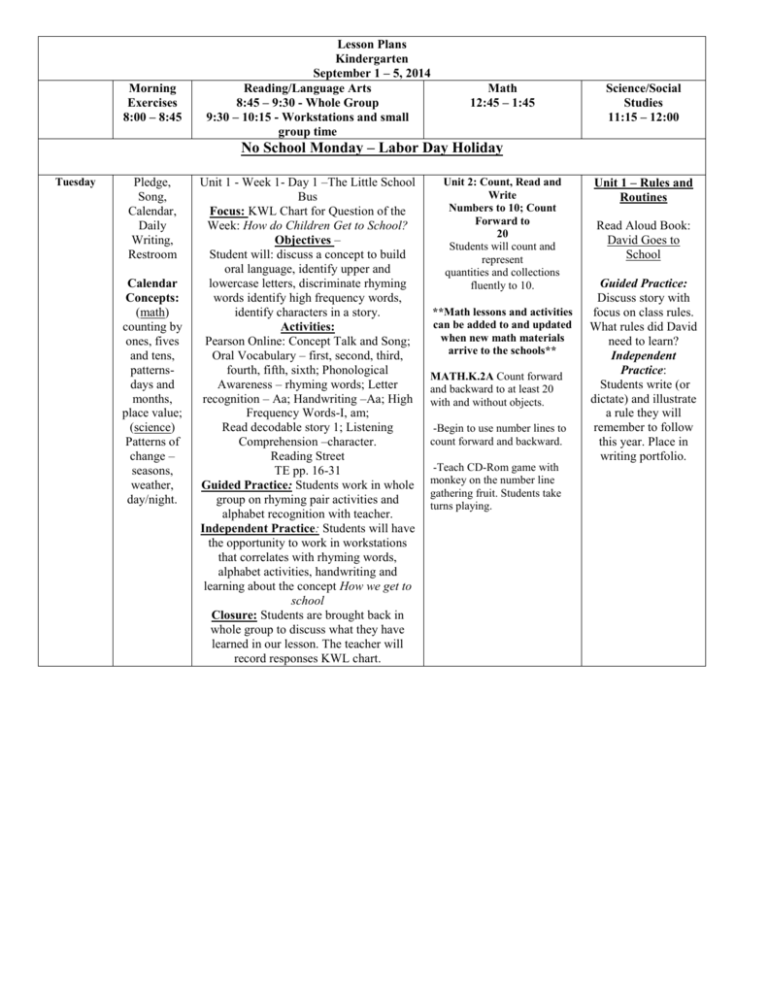
Morning Exercises 8:00 – 8:45 Lesson Plans Kindergarten September 1 – 5, 2014 Reading/Language Arts 8:45 – 9:30 - Whole Group 9:30 – 10:15 - Workstations and small group time Math 12:45 – 1:45 Science/Social Studies 11:15 – 12:00 No School Monday – Labor Day Holiday Tuesday Pledge, Song, Calendar, Daily Writing, Restroom Calendar Concepts: (math) counting by ones, fives and tens, patternsdays and months, place value; (science) Patterns of change – seasons, weather, day/night. Unit 1 - Week 1- Day 1 –The Little School Bus Focus: KWL Chart for Question of the Week: How do Children Get to School? Objectives – Student will: discuss a concept to build oral language, identify upper and lowercase letters, discriminate rhyming words identify high frequency words, identify characters in a story. Activities: Pearson Online: Concept Talk and Song; Oral Vocabulary – first, second, third, fourth, fifth, sixth; Phonological Awareness – rhyming words; Letter recognition – Aa; Handwriting –Aa; High Frequency Words-I, am; Read decodable story 1; Listening Comprehension –character. Reading Street TE pp. 16-31 Guided Practice: Students work in whole group on rhyming pair activities and alphabet recognition with teacher. Independent Practice: Students will have the opportunity to work in workstations that correlates with rhyming words, alphabet activities, handwriting and learning about the concept How we get to school Closure: Students are brought back in whole group to discuss what they have learned in our lesson. The teacher will record responses KWL chart. Unit 2: Count, Read and Write Numbers to 10; Count Forward to 20 Students will count and represent quantities and collections fluently to 10. **Math lessons and activities can be added to and updated when new math materials arrive to the schools** MATH.K.2A Count forward and backward to at least 20 with and without objects. -Begin to use number lines to count forward and backward. -Teach CD-Rom game with monkey on the number line gathering fruit. Students take turns playing. Unit 1 – Rules and Routines Read Aloud Book: David Goes to School Guided Practice: Discuss story with focus on class rules. What rules did David need to learn? Independent Practice: Students write (or dictate) and illustrate a rule they will remember to follow this year. Place in writing portfolio. Wednesday Pledge, Song, Calendar, Daily Writing, Restroom Calendar Concepts: (math) counting by ones, fives and tens, patternsdays and months, place value; (science) Patterns of change – seasons, weather, day/night. Unit 1 - Week 1- Day 2–The Little School Bus Focus: Review and add to KWL Chart for Question of the Week: How do Children Get to School? Objectives – Student will: discuss a concept to build oral language, identify upper and lowercase letters, discriminate rhyming words identify high frequency words, identify characters in a story. Activities: Review online - Concept Talk/Song; Oral Vocabulary – first, second, third, fourth, fifth, sixth; Phonological Awareness – rhyming words; Letter recognition –Bb Handwriting –Bb High Frequency WordsI, am; Read decodable story 1; Read Big Book: The Little School Bus - Listening Comprehension –character. Reading Street TE pp. 32-49 Guided Practice : Students will continue to work on Rhyming activities through whole group instructions – My skills buddy book , handwriting activities in readers writers notebook and reading comprehension skills Independent Practice: Students will be introduced to workstations that focus on identifying rhyming pairs, letter recognition games, high-frequency word search, and reading in small group with the teacher. Unit 2: Count, Read and Write Numbers to 10; Count Forward to 20 Students will count and represent quantities and collections fluently to 10. **Math lessons and activities can be added to and updated when new math materials arrive to the schools** MATH.K.2B * Read, write, and represent whole numbers from 0 to at least 20 with and without objects or pictures. -Begin using math problem solving boards to solve word problems/ journal prompts. - Model on smart board how to solve a word problem (read aloud several times for all students to visualize and process) by recording pictures, numbers and words. Unit 2 – Using the 5 Senses SCI.K.4.B – Uses senses as a tool of observation to identify properties and patterns of organisms, objects and events in the environment. Guided Practice : Introduce 5 Senses Read and discuss book: 5 Senses by Aliki. Add words to science wordwall: see, hear, touch, taste, and smell. Have students pantomime the five senses for their classmates to guess. Independent Practice: Students will respond to the lesson through writing (or dictations) and illustrations in science journal. Thursday Pledge, Song, Calendar, Daily Writing, Restroom Calendar Concepts: (math) counting by ones, fives and tens, patternsdays and months, place value; (science) Patterns of change – seasons, weather, day/night. Friday Pledge, Song, Calendar, Daily Writing, Restroom Calendar Concepts: (math) counting by ones, fives and tens, patternsdays and months, place value; (science) Patterns of change – seasons, weather, day/night. Unit 1 - Week 1- Day 3 –The Little School Bus Question of the Week: How do Children Get to School? Objectives – Student will: discuss a concept to build oral language, identify upper and lowercase letters, discriminate rhyming words identify high frequency words, identify characters in a story and practice retelling. Activities: Concept Talk; Oral Vocabulary – first, second,; Phonological Awareness – rhyming words; Letter recognition – CcHandwriting –CcHigh Frequency Words-I, am; Read Decodable Reader 1; Listening Comprehension –character, retelling. Reading Street TE pp. 50-81 Guided Practice : Students continue to work on the Amazing words introduce the word ,demonstrate the word ,orally generate rhyming words ,letter recognition for letter Cc Independent Practice: - Students are working in workstations that relates to rhyming activities, handwriting activities, and writing the room to find highfrequency words. Students working in small group with the teacher reading the decodable reader. Unit 1 - Week 1- Day 4–The Little School Bus Question of the Week: How do Children Get to School? Objectives – Student will: discuss a concept to build oral language, identify upper and lowercase letters, discriminate rhyming words identify high frequency words, identify characters in a story. Activities: Concept Talk; Oral Vocabulary – third, fourth; Phonological Awareness – rhyming words; Letter recognition –Dd Handwriting –Dd High Frequency WordsI, am; Read Kindergarten Student ReaderK.1. 1; Listening Comprehension –character. Reading Street TE pp. 82-93 Unit 2: Count, Read and Write Numbers to 10; Count Forward to 20 Students will count and represent quantities and collections fluently to 10. **Math lessons and activities can be added to and updated when new math materials arrive to the schools** MATH.K.2C Count a set of objects up to at least 20 and demonstrate that the last number said tells the number of objects in the set regardless of their arrangement or order. Begin using math manipulatives and number cards (1-5) to build it, draw it, write it for each number card. (Example – students pick a card for number four, count out four farm animal counters into a corral run off on tag, then draw four farm animals in a corral and write the number 4.) Unit 2 – Using the 5 Senses SCI.K.4.B – Uses senses as a tool of observation to identify properties and patterns of organisms, objects and events in the environment. Guided Practice: Introduce ‘5 Senses’ activities to the Science Center and model how to do each activity. Independent Practice Allow children time to practice using the materials with a small group. See Developing Number Concepts, Book 1 by Kathy Richardson, Black line masters including 14-17 for numeral cards for 1-6 and 1-10. Unit 2: Count, Read and Write Numbers to 10; Count Forward to 20 Students will count and represent quantities and collections fluently to 10. **Math lessons and activities can be added to and updated when new math materials arrive to the schools** MATH.K.2D Recognize instantly the quantity of a small group of objects in organized and random arrangements. -Use interactive dice on smart board to have students begin identifying organized arrangements of dots from 1 – 6. Have students take turns practicing rapid recognition on smart board, then work in pair with large dice taking turns rolling and quickly identifying the correct number. Making Rules: Our Government “People in Charge” Sing song “I Know a Teacher” (Avenues Language Chart/CD) Discuss: Who is in charge in a classroom? What does a teacher do? Who is in charge of a school? City? State? Our country? Students write/dictate and illustrate, “If I were a teacher, I would…” Students share their product with classmates.



